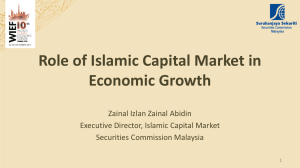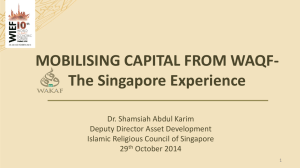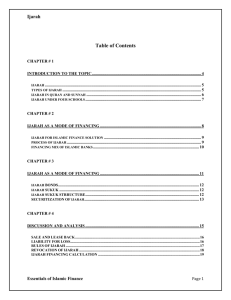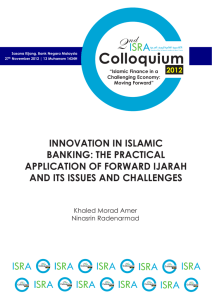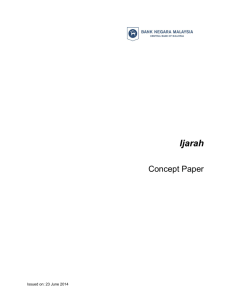Sales-based Contract
advertisement
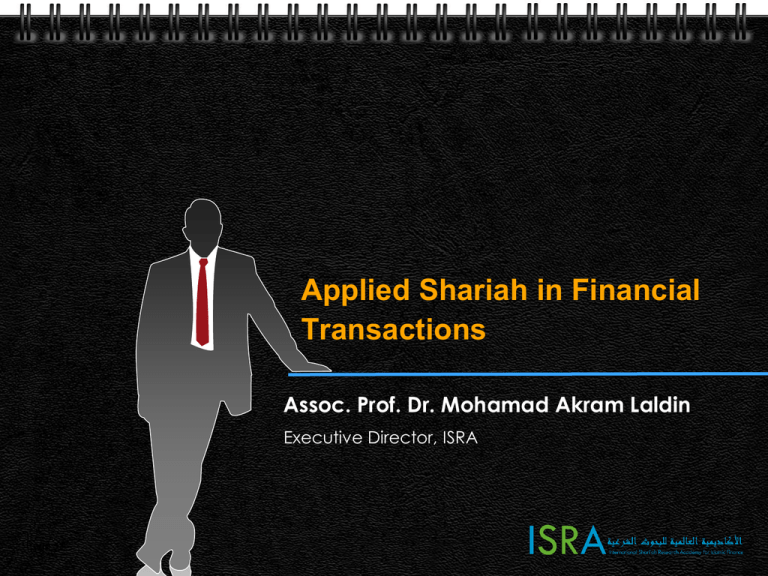
Applied Shariah in Financial Transactions Assoc. Prof. Dr. Mohamad Akram Laldin Executive Director, ISRA Page 1 Presentation Outline Page 2 1 Essential Shariah Guidelines 2 Islamic Contracts and Products 3 Islamic Investment Products Details • Essential Shari’ah Guidelines • Islamic Contracts and Products: Deposit – taking Contracts Sale – based Contracts Lease – based Contracts Equity – based & Hybrid Contracts Fee – based Contracts Other Supporting Contracts • Takaful • Investments Products 3 Page 3 Transaction in Islam Any transfer of wealth or property has to be made through a valid contract or `aqad Divine Sources (Quran & Sunnah) Mutual Consent • Contracts in Islam is the linking of offer and acceptance, resulting in legal effects on the subject matter of the contract. • In Islamic law, `contracts includes both bilateral as well as unilateral 4 Page 4 Essentials of Valid Contract CONTRACTUAL EXPRESSION Offer Acceptance • Clear • Corresponding of offer & acceptance 5 Page 5 CONTRACTING PARTIES Offeror Offeree • Of full contractual capacity • Legal authority to contract • As owner & in possession of asset • legal representative (agent, guardian etc.) SUBJECT MATTER Goods/ asset Price/ consideration • Something of value • Ascertainable • Legal General Principles in Transaction CONTRACT AS BASIS OF TRANSACTIONS Mutual consent Interest 6 Page 6 Uncertainties Lawful Contractual Objective AVOID Gambling Other prohibitions Eg: liquor, pork Freedom of Contract 7 Page 7 Islamic law of transaction : combination of fixed & flexibility Valid: Consent + Non- violation of Text األصل في األشياء االباحة “The original ruling is permissible” Hadith: Muslims are bounds by conditions they make Promote Maslahah Freedom from Riba Entitlement to Equal, Adequate, Accurate Info. Promote Brotherhood Freedom from Gharar A system grounded on moral and ethics Freedom from Dharar Freedom to Contract Characteristics of Shariahcompliant Banking and Financial System Freedom from Price control & Manipulation Page 8 Freedom from Qimar & Maysir Entitlement to Transaction at Fair Price Various Forms of Islamic Contracts Used in Banking Deposit-taking Contracts Promise/Undertaking Wa`ad Sales-based Contracts BBA – deferred sale; Murabahah – cost-plus sale; Bai al-Inah, Bai al-Tawarruq Lease-based Contracts Ijarah Wa Iqtina; Ijarah Thumma Al-Bai’, Ijarah Muntahia Bitamleek Equity-based Contracts Mudarabah, Musyarakah Fee-based Contracts Hybrid Contracts 9 Wadi’ah Yad Amanah; Wadiah Yad Dhamanah, Mudarabah; al-Qard Kafalah/Dhaman (Guarantee); Wakalah (agency) Musyarakah Mutanaqisah (Dimishing Partnership), AITAB etc. Page 9 9 Conceptual Balance Sheet of an IFI Assets Liabilities Trade Finance (Mudarabah/ BBA) Custodial Services (Amanah/Wadiah) Asset-backed Securities (Ijarah/Salam/Istisna) 10Page 10 Deposits/Investments (Mudarabah/ Wakalah) Fund Management (Mudarabah/ Special Mudarabah/Musyarakah) Fund Management/ Private Equity Venture Capital (Special Mudarabah/ Musyarakah) Fee-based Services/ Advisory (Wakalah/Jualah/Kafalah) Capital Owners’ Equity (Musyarakah) 11Page 11 DEPOSIT SERVICES PRODUCTS Saving/ Current Account Qard or Wadi’ah Yad Dhamanah 12Page 12 Investment Account Mudarabah Negotiable Islamic Deposit Certificate (NIDC) Sale & Buy Back Arrangement (SBBA) Bay’ al-`inah Bay’ al-Dayn Qardh (Loan) Qardh means non-interest bearing loan or benevolent loan The borrower is only obliged to pay the loan at its original amount to the lender within the agreed stipulated period of time In the Qard saving account, the bank will take deposit from the client and it is considered as a loan to the bank The bank is not allowed to promise any return as it will be constituted as riba Since it is a loan, the bank is allowed to utilise the fund and return back the deposit to the customer when they request them Page 13 WADI’AH Contract bet. Depositor and Custodian WADI’AH Trust Contract Custodian cannot benefit from the item Page 14 To keep the property of another in a safe custody by explicit and implicit terms How Bank Can Benefit From Wadiah Contract? The Wadi`ah Contract is combined with Guarantee contract (Dhaman or Kafalah) Page 15 Wadi`ah Yad Dhamanah (Guaranteed Safe Custody) DHAMAN / KAFALAH Liability Custodian liable for loss/ damage Usage Custodian may utilize the deposited item Profits Profit arising from the use is sole right of custodian Page 16 DHAMAN / KAFALAH A guarantee contract Wadi`ah Yad Dhamanah – The custodian is a trustee and guarantor to safeguard the deposited asset. – The deposited asset/property need not be separated/segregated – The deposited asset/property can be used for trading etc. – The custodian has a right to any income derived from the utilisation of the deposited asset – Depositor can take back the deposited asset at any time – Wadi`ah Yad Dhamanah is like Qard (loan); therefore all principle of loan would be applicable – Thus as a loan WYD cannot generate any preagreed benefit/income to the depositor, over and above the principal amount of deposit, otherwise tantamount to riba 17Page 17 Shariah Issues Current Account Overdraft facility Saving Account Advertisement of hibah prior or at time of contract Page 18 Deposits from Individual / Companies Minor (Guardian) Hibah Insufficient fund for cheque clearance Mudarabah 19Page 19 A profit sharing contract & a trust contract Parties: Rabbul Mal (Capital Provider) Mudarib (entrepreneur) Profit will be distributed based on agreed ratio Loss: Rabbul Mal lose his capital and Mudarib lose his work Issues To Be Considered • • • • • • 20Page 20 Investment from certain individuals and companies Investment of a minor Advertisement of gift prior to the contract Guaranteeing profit/capital? Variation of the ratio of profit and loss sharing Pre-mature withdrawal of capitalmudarabah investment Other Deposit Products / Structures Commodity Murabahah Deposit-i Structured based on Tawarruq Structured Deposit Products Pure Al-Qard Structures Absolutely no returns or benefits provided to depositors E.g., Al-Rajhi Malaysia’s savings and current accounts Combination Structures Each deposit split into stipulated portions (Mudarabah & Qard) E.g., KFH Malaysia’s savings and current accounts 21Page 21 22Page 22 Murabahah & Bay` Bithaman Ajil Bay` Tawarruq Bay` `Inah Common Types of Sale-based contract Bay` Istisna’ 23Page 23 Bay` Salam Murabahah 24Page 24 Cost plus mark up sale Seller disclose the actual cost and the added profit margin Payment may be on spot basis or deferred It is different prom Musawamah (sale based on bargain) Basic Shari`ah Rules on Sales 25Page 25 1. Subject of sale must be existing at time of sale 2. Subject of sale must be owned by seller at time of sale 3. Subject of sale must be in physical or constructive possession of seller at time of sale 4. Sale must be instant and absolute 5. Subject of sale must be of value 6. Subject of sale cannot be for haram use 7. Subject of sale must be specifically known and identified 8. Certainty of delivery 9. Certainty of price 10. Sale must be unconditional Application of Murabahah in Finance (Murabahah To The Purchase Orderer ) • It is a sale in which two parties or more negotiate and promise each other to execute an agreement according to which the orderer asks the purchaser to purchase an asset of which the latter will take legal possession. • The orderer promises the purchaser to purchase the asset from him and give the ordered a profit thereon. The two parties would conclude a sale after the possession of the ordered to the asset. 26Page 26 Murabahah Trade Financing Customer buys commodity via murabahah on deferred payment terms Trader transfers Commodity to Bank Customer identify the commodity Customer approaches bank and promises to buy commodity from bank 27Page 27 Bank buys commodity on cash basis Bay` al-Inah? Sale and buy back Seller sell at deferred price and buyer sell back with cash price 28Page 28 Profit difference between deferred and spot price Bay’ al-Inah: Personal financing How can I borrow RM100,000 to get married? Bank sells asset RM 150,000 Customer pays on deferred Banks Pays on cash basis RM 100,000 29Page 29 Customer sells back asset Bay’ Al Inah Legal Sale and buy back with some time interval Page 30 Sale and buy back without any intention to do so Coincidence Sale and buy back with similar price Illegal Sale and buy back after some modification to the object 30 Two contracts are tied (conditione d upon another) Two sales in one Tawarruq Tripartite sale/ Cash procurement Buyer buys an asset from a Seller on deferred payment and then, sells the assets to the Third party for cash 31Page 31 Intent Not sale transaction but to acquire cash Tawarruq Model of Home Financing 4.Property 4.RM200,000 Customer Property Owner/Developer 2.RM350,000 Deferred 3.RM200,000 2.Electrical Appliances 1.RM200,000 Page 32 32 Electrical Appliances Wholesaler 1.Electrical Appliances worth RM200,000 Commodity Murabahah Deposit-i US$ 1 Million Cash US$ 1.1 Million deferred Broker B US$ 1 Million Cash Broker A 33Page 33 Ruling on Tawarruq Organized Tawarruq Classic Tawarruq Allowed by many jurist - condition: object not sold back to Original Seller Page 34 Prohibited by some jurist such as Ibn Qayyim Allowed by some jurist and applied in some IFIs 34 Prohibited by most jurists - Similar to ‘Inah Bai’ Bithaman Ajil (BBA) 35Page 35 Deferred sale BBA is originally not a kind of sale Rather, it is a way in which the payment of the sale price is made i.e. Deferment. In Malaysia, BBA refers to long term deferred sale, while murabahah refers to short term deferred sale. BBA HOME FINANCING MODUS OPERANDI 5. Bank pay developer the 90% balance Developer/Vendor Sales & Purchase Agreement (S&P) 1. 10% down payment 1. Beneficial ownership Property Sale Agreement (PSA) 3. BBA price (deferred payment) 3. House 2. House 2. Cash price (90% balance) BANK Page 36 Property Purchase Agreement (PPA) Customer Financing Facility: Islamic Banking vs. Conventional Banking Fin. Amount Tenure : RM100K : 25 yrs (1981-2005) Single Rate : BFR-0 Ceiling Rate : 9.90 Ta’widh : 1% Total Selling Price Page 37 Loan Amount Tenure Single Rate Ceiling Rate Penalty : RM100K : 25 yrs (1981-2005) : BLR-0 : -no: 8% compounded Total Repayment MOVEMENT OF BASED LENDING RATE (BFR) Page 38 39Page 39 Ijarah (Leasing) • 40Page 40 Ijarah contract is a form of exchange contract (`aqd al mu`awadah) – usufruct vs. rent. • Ijarah (Operating Lease) means leasing of asset pursuant to a contract under which a specified permissible benefit in the form of a usufruct is obtained for a specified period in return for a specified permissible consideration. • It is a manfaah (usufruct) type of contract whereby a lessor (owner) leases out an asset to its customer at an agreed rental fee and pre-determined lease period upon the `aqad (contract). The ownership of the leased equipment remains in the hands of the lessor. Ijarah Muntahiah Bi Tamlik (Financial Lease) • 41Page 41 Ijarah Muntahiah Bi Tamlik has similar rules to the ordinary Ijarah except that it is associated with a promise by the lessor to transfer ownership at the end of the Ijarah period via a separate sale agreement or gift. DIRECT LEASING 3. Bank pays airplane manufacturer 5. Bank lease airplane to airline 4. Airplane manufacturer delivers airplane to bank 6. Airline pays rental 2. Airline approaches bank to seek financing 42Page 42 7. At the end of lease term airline take ownership 1. Airline places order with airplane manufacturer Ijarah Mausufah Fi Zimmah (Forward Lease) • • • • 43Page 43 Ijarah Mausufah Fi Zimmah means an ijarah contract which is executed for an asset undertaken by the lessor to be delivered to the lessee according to accurate specifications, even if the asset is not owned by the lessor. During the period that the leased asset/property is under construction, the lessor may ask the lessee to pay a certain portion of pre agreed lease rental as a forward lease. The forward lease rental payment will be considered as a debt to the lessor until the delivery of the leased asset to the lessee. Ijarah Mausufah Fi Zimmah can be in a form of Ijarah or Ijarah Muntahiyah Bi Tamlik. Salient feature of Ijarah 44Page 44 Asset: Valuable use / usufruct. Not consumable Ownership remain with lessor; usufruct transfer to lessee Liabilities and risks incidental to ownership will reside with the lessor Liabilities, risks or expenses refer to the use of the leased asset reside with lessee Cont’d… 45Page 45 • The purpose and mode of usage should be agreed upfront • The lessor could be the legal owner or the equivalent (agent, natural or legal guardian) • The leased asset is a trust in the hands of the lessee. • The rental payment commences after the delivery of the leased asset, actually or constructively. • The lease contract terminates upon the loss / nonexistence of the usufruct • Lease contract is a bilateral contract. Any termination, in normal cases, must be mutually agreed. 46Page 46 Musharakah 47Page 47 Profit –Loss Sharing contract Technically it refers to the commingling of capital provided by the partners for the purpose of sharing in profit Profit will be distributed based on agreed ratio Loss will be distributed based on parties’ equity ratio Musharakah (Profit Loss Sharing) Venture Profit or Loss Capital Partners Profit n Loss Sharing Page 48 Application: • Home Financing: Diminishing Musharakah • Sukuk • Equity Shares • Project Financing • Letter of Credit Musyarakah Mutanaqisah (Diminishing Partnership) • Musyarakah mutanaqisah is a form of Musyarakah (partnership) in which one of the partner promises to purchase the equity share of other partner gradually until the title of the equity is completely transferred to him. • This transaction starts with the formation of partnership, after which buying and selling of the equity take place between the two partners. • One partner may lease his share of the asset to the other partner on Ijarah (lease) basis. • The partnership will come to an end with one partner being the sole owner of the asset or business venture. Page 49 Musyarakah Mutanaqisah (Modus Operandi) Bank leases its 90% share of property to customer 90% 10% 0% 100% Customer pays rent for usage of Bank’s 90% share of property Customer gradually buys share of property from Bank Page 50 Customer’s monthly installment payments ILLUSTRATION of Musharakah Mutanaqisah Customer’s Share The asset is now mine. Thanks to Islamic Bank MM Bank’s Share 90% 100 90 80% 80 70% 70 Customer now owns 100% of the Assets 30 20 51 Page 51 50% 50 40 10% 60% 60 10 40% 30% 20% 10% Bank’s share = “0” Differences Between Murabahah & MM? No BBA Musharakah Mutanaqisah 1 Involves a Sale Contract Involves Partnership, Leasing and Sale contracts 2 Contract – Buyer & Seller Contract – Partnership 3 Require underlying assets to complete Aqad (APA & ASA) Underlying assets not required 4 With Selling Price – Fixed No Selling Price – Flexible 5 Security documents Asset Purchase Agreement Asset Sale Agreement Charge/Deed of Assignment Security documents MM Co-Ownership Agreement Charge/Deed of Assignment 6 Property belongs to the customer Property belongs to both the customer and the bank according to the percentage of ownership Page 52 53Page 53 Delegation (al-Wakalah) • • • 54Page 54 Wakalah is a contract of agency which gives the power to a person to nominate another person to act on his behalf as long as he is alive based on the agreed terms and conditions. Wakalah is commonly used in Letter of Credit-i Delegation Al-Wakalah has four pillars: 1. The Delegator Al-Muwakkil 2. The Delegatee Al-Wakeel 3. The wording of the Delegation 4. The subject of the Delegation Letter of Credit (LC)- Wakalah Seller (Beneficiary) Advice LC Need to produce Required documents Eg. commercial invoice BL (Bill of landing), etc Buyer (Applicant) Apply LC Issue LC 55Page 55 Advising Bank Issuing Bank 56Page 56 Wa`ad (Promise) An undertakin g to do something in future 57Page 57 Involves the promisor and promisee Waad is not contract It is unilateral and binding on the maker only 1st Group 2nd Group (Hanafis, Shafi`is, Hambalis (Samurah b. Jundub, Umar Abdul Aziz,Hasan al-Basri, a;-Ashwa’, Ishaq Rahwaih, Al-Bukhari & some Malikis) and some Maliki jurists) Fulfilling a promise is noble but it is neither mandatory nor enforceable through a court of law Fulfilling a promise is mandatory & the promisor is under a moral and legal obligation to honor his promise. WA`AD (PROMISE) 3rd Group (Some Maliki Jurists) Promise is not binding under normal circumstances but becomes binding where the promisor has caused promisee to incur certain expenses or undertake work or any Page 58 form of liability 4th Group (Islamic Fiqh Academy – Generally accepted view) Fulfilling a promise is allowed subject to certain conditions as enumerated in the next slides 58 Islamic Fiqh Academy Position on Promise Promise in commercial dealings are binding subject to the following conditions: 1. It should be one-sided promise 2. The promise must have caused the promisee to incur certain liabilities for the promisee to seek enforcement on the promisor 3. If the promise is to purchase something the actual sale must take place at the appointed time by the exchange of offer and acceptance. A mere promise itself should not be taken as a concluded sale 4. If the promisor bakes out of his promise, the court may force him either to purchase the commodity or pay actual damages to the seller. The actual damages include the monetary loss suffered by the promisee, but shall not include the opportunity cost. Page 59 59 60Page 60 BASIC MECHANISM OF INSURANCE Profit No Claim Premium Policy holder Insurance Company Peace of mind Calamity Compensation Page 61 Conventional Insurance: Not Shari’ah-compliant • Element of uncertainty (gharar) – There is uncertainty of what the insurance policy-holder is “buying” or paying for • If no loss occurs Policy-holder receives nothing • If loss occurs Policy-holder gets compensation in varying amounts Premium Insurance Company • • Page 62 Insurance Policy-holder Coverage Element of gambling (maysir) – The insurance company is gambling that total premiums collected will exceed total claims and thus producing underwriting surplus (profit) – Total claims is predominantly affected by chance (will of God) Element of riba – Insurance fund commonly invested in interest-bearing securities Page 63 SHARI`AH LEGITIMACY OF TAKAFUL َ و ُنو ْا و ُنو ْا َ وال َ تَعَا َ وى َ وال َّت ْق َ بر َ وتَعَا َ ِِّ ِّ علَى ا ْل َ وان ُ وا ْل َ ع ْد َ م ِّ اإل ْث ِّ علَى “and help ye one another in righteousness and piety, but help ye not one another in sin and rancour” (5:2). Hadith • “…tie the camel, then submit (tawakkal) to the will of God.” • Importance of risk mitigation Islamic Legal Maxim الضرر يزال Page 64 BASIC DESCRIPTION OF TAKAFUL INSDUSTRY Takaful Operator Takaful Participants Manages fund for a fee or share in profits on investment Takaful Fund • • • • Page 65 Contribute via unilateral contract (tabarru’at) Takaful participants contribute to a takaful fund based on the concept of mutual assistance The contribution is done via reciprocal/mutual donation (tabarru’at) and does not represent a commercial “sale of coverage” Takaful entails a unilateral, charitable contract (tabarru’at) in contrast with the conventional insurance contract which is a bilateral exchange contract (mu’awadat) Gharar is tolerated in a charitable unilateral contract Takaful: Wakalah Model Takaful Participants Wakalah fee Contribute 1st contract Tabarru` 2nd Contract Wakalah Risk Fund Manage Takaful Operator 66 Page 66 Surplus -retakaful -reserves -claims -investment income -stabilization reserves Takaful: Mudarabah Model Takaful Participants Contribute 1st contract Tabarru` 2nd Contract Mudarabah 1. Unilateral contract 2. Valid though no acceptance and consideration from the recipient Takaful Funds Manage Invest Takaful Operator Profit, if any, is shared between the two based on certain ratio or percentage & loss, if any, will be borne by the capital provider alone Page 67 67 Pay Claims Takaful vs. Insurance Basis 68Page 68 Conventional Insurance Takaful Principles Non compliance with Shari`ah principles In compliance with Shari`ah principles Contract Buying & Selling Tabarru` , Wakalah & Mudarabah Obligation of Company Guarantor to insured Fund Manager Guarantee Given By Company Participants Mutually guarantee each other Page 69 Literal Meaning Sukuk is the plural of sak which means certificates. Other similar terms: •Taskik – process of dividing assets into papers (sukuk) •Tawriq – to render something into cash AAOIFI “Investment sukuk are certificates of equal value representing undivided shares in ownership of tangible assets, usufructs and services (in the ownership of) the assets of particular projects or special investment activity” Page 70 Technical Meaning SUKUK Sukuk refers to securities, notes, papers or certificates, with features of liquidity and tradability (except for salam and murabahah sukuk) Malaysian Securities Commission “A document or certificate which represents the value of an asset” • Asset – may include financial asset such as receivables and debts, as well as non financial assets like tangible assets, usufructs and services. Obligor/Project Developer Proceeds from Sukuk Sales Issuer/Trustee BASIC STRUCTUR E OF SUKUK Issue Proceeds Sukuk Income from project Income Generating Page 71 Project Sukuk Investors Comparing SUKUK to BONDS Sukuk Bonds 1. Holder owns assets 1. Holder owns cash flow only 2. Use a variety of contracts to create financial obligations between issuer and investors; e.g. Sale, lease, equity partnership, joint-venture etc. 2. Simply use a loan contract to create indebtedness 3. Return linked to profit elements inbuilt in the sale, lease or partnership 3. Return linked to interest charged out of the loan contract 4. Instrument may be equity or debt depending on underlying contract 4. It is a Debt instrument 5. Tradability of the sukuk depends on 5. No restriction on the tradability the nature of the underlying asset 6. Investment in Shari`ah-compliant activities Page 72 6. Proceeds are invested in any business without restrictions Bases for Sukuk Classification The Underlying Contracts in the Sukuk Structures Sales-based Lease-based Partnership-based Agency-based The Nature and Type of Asset represented by the Sukuk Debt-based The Technical and Commercial Features of the Sukuk Asset-based (normal) Asset-Backed (ABS) Hybrid Structure (convertible & exchangeble ) Page 73 Tangible assets Usufructs Rights in investment projects Special investment activities Types of Sukuk Asset-Based Sales-Based Lease-Based AssetBacked PartnershipBased BBA Ijarah Mudarabah Murabaha h Ijarah Muntahiya bi Tamlik Musharakah Salam Istisna Page 74 Ijarah Mawsufah fi Zimmah Hybrid AgencyBased Convertible Exchangeable Wakalah bil Istithmar 2. Sell the asset on tendered basis 1. Issuer identified asset 3. Subscriber cum tender panel member provide proceeds TPM/Underwriter s 4 Disburse the purchase price 5. Subscriber resale the asset at selling price (mark-up, i.e. Murabahah) Primary Subscriber Issuer MUNIF Debt (Selling price) is evidenced by issuance of MUNIFs MUNIF Basic Structure Page 75 May sell MUNIF in Secondary Market (Bay al-Dayn) BASIC STRUCTURE: IJARAH SUKUK 1. Sale of assets to the primary subscribers 2. Lease back assets to issues in return for ijarah rental (periodic distribution) Primary Subscriber Sukuk Issuer 3. Issue Sukuk Ijarah as evidenced of undivided proportionate ownership of leased asset + right to ijarah rental stream Page 76 Secondary Market Trading Investors STRUCTURE OF MUDHARABAH SUKUK Issues Mudarabah Sukuk Contract of Mudarabah 1 Investors (Rabb al-Mal) Profit shared in accordance to pre-agreed proportions (X,Y) Y% to rabb al mal Issuer (Mudarib) CAPITAL X% to Mudarib 3 Loss? borne totally by rabb al-mal Page 77 Outcome Of Project 2 Invests in project Rental from halal activities Islamic REITs Return from Islamic REITs Rental from mixed activities (halal + haram) Method to calculate rental From non halal activities Instruments used in deposit, investment and financing i-REIT Fund Management Takaful Protection Risk management issue Page 78 Islamic REITs Shariah advisors Unit Holder Advise on Shariah issues Investment Returns Safeguard unit holder’s interest Management services REITs Management fees Trustee fees Ownership Of Property Manager Trustee Net Property Income Property Page 79 Manager Maintenance and Management Services Rent Maintenance and management fees Rental Payment Properties Tenant Shariah Issues involving Rental from Lessee who conduct Mixed Activities The core activity is halal but small portion of the whole activity is not- halal Method of calculation Principle The non halal ration must not exceed 20% of the total rental from Islamic REITS `Umum Balwa Maslahah Benchmarking Page 80 In calculating the ratio of nonhalal activity: usage of the space, length of service and others are applied If the width of the supermarket is 10,000 sqf, and the designated area for sale of liquor is 1000 sqft, namely 10%. It is still within the acceptable ratio Islamic Structured Products Fund-Mobilization Stage Investment Activities Stage Wakalah bi al-istithmar-based structured investment Client’s investment Invest 90% Fixed Income Investments 100% Client BANK Bank acts as agent (wakalah contract) in investing depositor’s money & charges a fee for the service -Commodity murabahah - Sukuk, Islamic ABS (Asset-Backed Securities) Invest 10% Higher Return Investments -equity, derivatives e.g. Options, swaps, futures & forward Expected Return x% Page 81 Expected Return 10% Principal Protection = (90% investment + 10% return) Shariah Issues Structuring 1. Identifying contract and principle • Fund raising stage – Wakalah/Mudarabah • Investment activities– Tawarruq, purchasing basket of shares, embedded Islamic Option (wa`d or urbun etc) • Wa’d, Wa’dan or Muwa`adah? 2. Underlying aset and investment activities Implementation 1. Each contract has to be executed separately & follow the right order 2. Capital protection objectives • Efficient fund management • Third party guarantee (subsidiary to principal/other branch of an international IFI) Usage 1. Replacement of securities (Shariah compliance status changes) 2. Wa‘d to sell and buy equity based on ‘benchmark’ : Iqnorance of price 3. Early settlement: Justification? Page 82 THANK YOU Page 83



